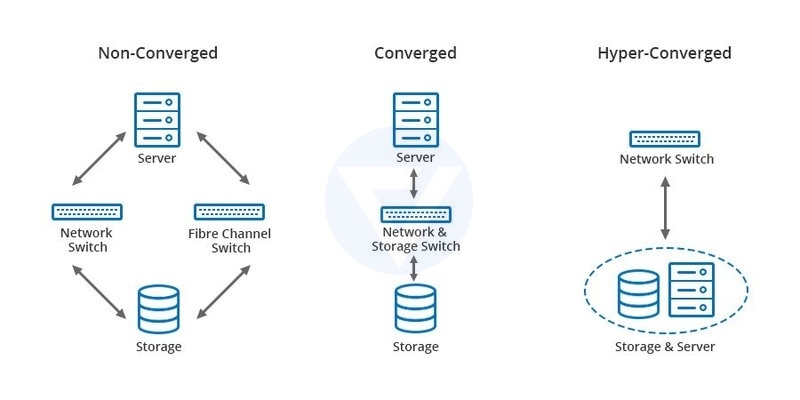
Hyper-Converged Infrastructure
HCI, or Hyper-Converged Infrastructure, is an IT infrastructure model that combines computing, storage, and networking resources into a single, highly integrated system. HCI is designed to simplify data center operations and reduce the complexity of managing IT infrastructure.
Traditionally, data centers have relied on separate servers, storage arrays, and networking equipment, each with their own management interfaces and protocols. HCI eliminates this complexity by integrating all of these resources into a single system that can be managed through a single management interface.
HCI typically consists of a cluster of servers, each with its own set of compute, storage, and networking resources. The servers are connected through a high-speed network fabric, which allows them to share resources and communicate with each other.
One of the key benefits of HCI is its scalability. As the demand for resources grows, additional servers can be added to the cluster, allowing the system to scale up as needed. This makes HCI ideal for organizations that need to quickly and easily add capacity to their data center.
Another benefit of HCI is its ability to improve data center efficiency. By consolidating compute, storage, and networking resources into a single system, HCI reduces the need for separate hardware, which can reduce power and cooling requirements, as well as the physical footprint of the data center.
Overall, HCI is a powerful and flexible infrastructure model that can help organizations to simplify their data center operations, reduce complexity, and improve efficiency.
Hyper-Converged Infrastructure (HCI):
One of the key components of HCI is software-defined storage. Rather than relying on traditional storage arrays, HCI uses distributed storage that is managed by software. The storage is distributed across all of the servers in the cluster, which enables high availability and redundancy.
In addition to software-defined storage, HCI also uses software-defined networking. The networking component of HCI is designed to be highly scalable and flexible, allowing organizations to quickly and easily add or remove networking resources as needed.
Another important aspect of HCI is its management interface. HCI systems typically have a single management interface that allows administrators to monitor and manage all of the resources in the cluster, including compute, storage, and networking. This can simplify IT operations and reduce the need for specialized IT staff.
HCI is also designed to be highly resilient. Because the resources in an HCI system are distributed across multiple servers, the system can continue to function even if one or more servers fail. This can help to ensure high availability and minimize downtime.
Overall, HCI is becoming an increasingly popular infrastructure model for organizations that need to manage large amounts of data and require high levels of scalability and flexibility. By consolidating compute, storage, and networking resources into a single system, HCI can simplify IT operations, reduce complexity, and improve efficiency.
Hyper-Converged Infrastructure (HCI):
One of the key benefits of HCI is its ability to simplify IT operations. By consolidating compute, storage, and networking resources into a single system, HCI can reduce the complexity of managing IT infrastructure. This can free up IT staff to focus on more strategic initiatives, rather than day-to-day maintenance tasks.
Another important benefit of HCI is its scalability. Organizations can start with a small HCI cluster and then add additional resources as needed, making it easy to scale up or down based on changing business needs. This can be particularly useful for organizations that experience rapid growth or have unpredictable resource requirements.
HCI can also be an effective solution for organizations that have limited physical space for their data center. Because HCI systems are highly integrated and compact, they can help to reduce the physical footprint of the data center, which can be particularly valuable in urban areas where physical space is at a premium.
In terms of performance, HCI can offer excellent performance for a wide range of workloads, including virtualization, databases, and big data analytics. Because the resources in an HCI system are distributed across multiple servers, the system can provide high levels of performance and availability, even under heavy workloads.
Finally, HCI can be a cost-effective solution for organizations that are looking to reduce IT costs. By consolidating resources into a single system, HCI can reduce hardware and software licensing costs, as well as power and cooling costs. In addition, because HCI systems are highly integrated, they can be easier and less expensive to manage than traditional infrastructure models.
Overall, HCI is a flexible and scalable infrastructure model that can help organizations to simplify IT operations, improve performance and availability, and reduce costs.
HCI can be effective for a wide range of workloads, but here's an example of a workload that HCI would be particularly effective for:
Virtual desktop infrastructure (VDI) is a type of workload that involves running multiple virtual desktops on a single server. VDI can be resource-intensive, requiring a significant amount of compute, storage, and networking resources to support multiple users.
HCI is well-suited for VDI workloads because it can provide the necessary compute, storage, and networking resources in a highly integrated and scalable system. With HCI, organizations can easily add additional servers to the cluster as the number of virtual desktops grows, ensuring that the system can keep up with demand.
In addition, HCI can provide high levels of performance for VDI workloads. Because the resources in an HCI system are distributed across multiple servers, the system can provide the necessary compute and storage resources to support multiple virtual desktops simultaneously. This can help to ensure that users have a smooth and responsive experience when using virtual desktops.
Finally, HCI can be a cost-effective solution for VDI workloads. By consolidating compute, storage, and networking resources into a single system, HCI can reduce hardware and software costs, as well as power and cooling costs. In addition, because HCI can be managed through a single interface, it can be easier and less expensive to manage than traditional VDI infrastructure models.
Overall, HCI can be an excellent solution for organizations that need to support VDI workloads. By providing scalable, high-performance, and cost-effective infrastructure, HCI can help organizations to support multiple virtual desktops and improve the user experience.
Share It:
Tags:













